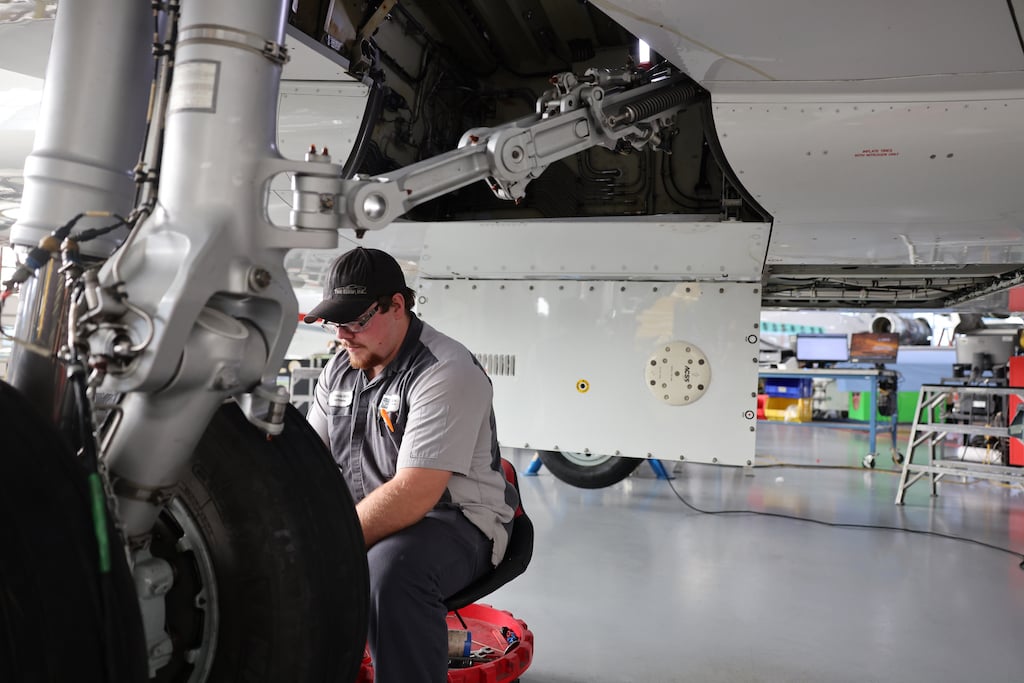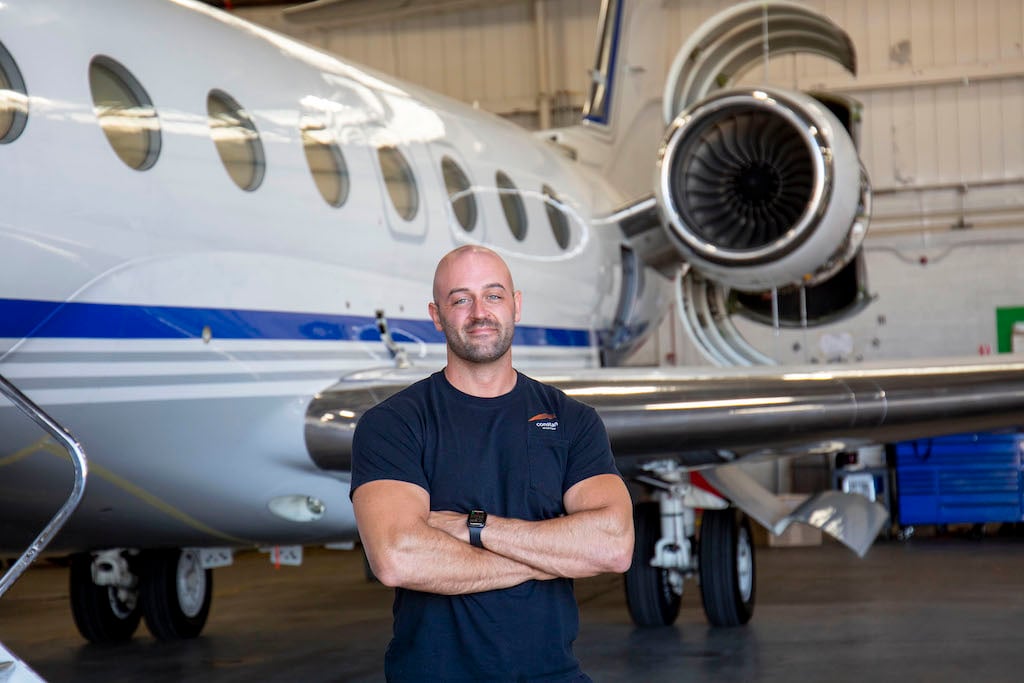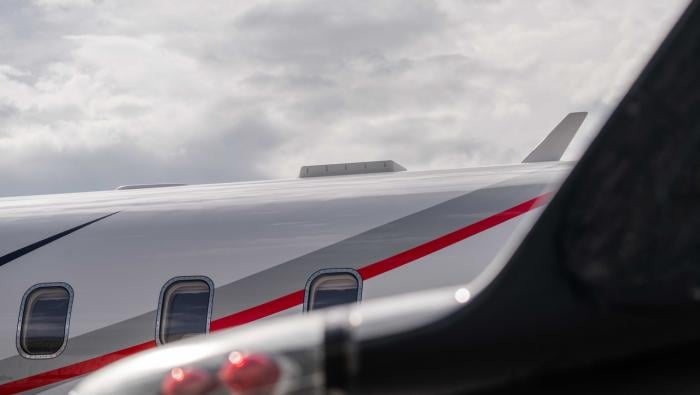As the business aviation industry moves into a new year, one trend in the maintenance sector that is unlikely to ease in 2023 or beyond is the mechanic shortage. That’s why some of the country’s biggest, independent MROs are addressing the issue directly by starting their own paid airframe and power plant (A&P) apprenticeships.
The positives of such programs for MROs are security in knowing that they have a pipeline from which to draw and engendering employee loyalty. It’s also an effective recruitment tool. For apprentices, it’s an opportunity to make a living wage while learning a technical trade that would otherwise cost them tens of thousands of dollars. According to Southern Utah University (SUU), aviation maintenance technician (AMT) schools can cost anywhere from $8,000 to $30,000 for an associate degree and $20,000 to $80,000 for a bachelor’s program. And the cost to train at a non-university AMT school can range from $20,000 to $50,000, according to SUU.
But for MROs developing such programs, it hasn’t been easy. There’s a learning curve and commitment associated with taking on an apprenticeship program, not only from the C-suite but at the employee- and apprentice-level as well.
Yet with a shortage of A&Ps unlikely to ease for years, those MROs that have taken on apprenticeship programs said the effort and cost are more than justified. “You have to invest in people. They don’t just materialize,” West Star Aviation's v-p of human resources Katie Johnson told AIN. “There’s definitely a cost to train, but there’s definitely a cost to not train.”
‘Trial and error’
At Duncan Aviation in Lincoln, Nebraska, the MRO provider launched its apprenticeship program in 2019. Darwin Godemann, team leader of Duncan’s technical education center, told AIN that the first cohort included six people, and showed the company that there was more to standing up an apprentice program than just having a curriculum and class outline. What Duncan learned was it needed to screen apprentices carefully, just as it would a job candidate.
“We got people who we found out it was kind of more exploratory for them,” said Godemann, who’s been with the program since its inception. “And they’d get in and say, ‘Oh, this is not what I wanted.’” Of those six, two finished the 24-month program. “We learned a lot along the way, kind of trial and error,” Godemann said.
As a result, the company began a selection program that was more “deliberate,” he explained, including a 90-day probation period. “If they show a strong aptitude and interest, then we offer them the opportunity,” Godemann added. Also, once formally in the program, apprentices and their team leaders sign a document of expectations that includes a tiered pay-back policy.
That policy, for example, calls for the apprentice to pay Duncan a sum of money if they leave the program and the company within four years. The peak of that tiered pay-back amount is $10,000 at 18 months, after which the amount eventually drops to zero. “If you give somebody something for free, if they don’t like it, they just walk away from it,” Godemann said. “If they’ve got skin in the game, then they’re like, ‘I’m really going to consider this before I sign up and if I step away, I might owe something for it. Now it’s evolved to where we have a much higher retention rate because we’re more deliberate on who we select.”
As of now, there are 70 apprentices enrolled through Duncan’s program that is Department of Labor-approved at its major facilities in Lincoln; Battle Creek, Michigan; and Provo, Utah. Some of the class content for apprentices at Battle Creek and Provo is provided through Microsoft Teams sessions, both live and recorded. Apprentices at those locations also have an instructor to lead them through hands-on training in addition to their mentors. More recently, Duncan has added training coordinators at Battle Creek and Provo to handle the administration of the program.

Duncan also is building out its tools at those two sites to enable a designated mechanic examiner (DME) to test students for their A&P certificates. “We’re not a 147 program, but the FAA has to come in and inspect the facility to make sure they have the minimum tools for the DME,” Godemann said.
An unanticipated perk of the program has been Duncan employees from other departments taking advantage of some of the apprenticeship classes. “For me, it’s kind of unexpected a little bit because even though we have the apprentice program and we’re targeting apprentices, we also have the curriculum and some of the training in place that will benefit other parts of the company,” Godemann said. “That’s been kind of a benefit.”
‘A dynamic thing’
At West Star Aviation, Johnson explained that with substantial growth in business demand in previous years, the East Alton, Illinois-based MRO focused largely on hiring experienced staff, including technicians. But around 2018, the company realized that the upcoming labor shortage “was really going to impact our future needs,” she said. That meant West Star—which also operates MRO facilities in Grand Junction, Colorado; Chattanooga, Tennessee; and Perryville, Missouri—had to become more structured and prepared for what lay ahead. First, it increased its partnerships with local workforce development teams and local school districts to increase its A&P talent pipeline.
And that led to the creation of its apprenticeship program in 2019 when it received approval from the state of Illinois. Those efforts allowed the company to attract students in high school and lower-income people to the three-year-long program. Those apprentices are paid and receive benefits during their on-the-job training. “Our apprenticeship program also supports transitioning military members,” Johnson said. “They have great experience but they don’t have a license.” The third component of its program is to provide part-time work for students who are attending a college A&P program. “It really helps them get that on-the-job learning while they’re in school getting that book theory,” she added. In all three scenarios, the apprentices are working alongside senior technicians and the training they receive is guided by the FAA’s hours and task requirements to test for their A&P certificate. At that point, and once the local Flight Standards District Office has verified and approved their training, West Star will pay the cost to send apprentices to Bakers School of Aeronautics—travel, lodging, wages—to attend a two-week test preparation course.
There are 50 apprentices in the program, and to date this year, eight have completed their training and received their A&P certificates. Since the inception of the program, about 25 apprentices have successfully completed their training and certification, Johnson added.
Johnson said there are many things the company has learned since launching the program. It requires senior technicians or leads to know they can provide apprentices with hands-on training. It also requires collaboration not just between the apprentice and the lead, but also with their manager, the training department, and human resources. One of the more recent initiatives at West Star is to meet monthly with the apprentices to discuss where they are at in their training, what documentation they have or need, and where they are struggling. “What that does is allow us to know where we need to apply more resources,” she said.
Most importantly, Johnson added, a company needs to understand that an apprentice program is a dynamic thing. “This is not a program you just design and check the box,” she said. “You really have to nurture it and spend time checking in with your apprentices to make sure they’re having a good experience and that the leads who are providing them training are able to do both. And then if there are any issues that aren’t working, you have to be able to say, ‘OK, let’s redirect resources,’ so that way the program continues to be successful.”
‘Delicate balance’
Constant Aviation has had apprenticeships for a long time, v-p of quality, safety, and training Kent Stauffer told AIN, but they were “kind of informal” and the need wasn’t the same when the company started them. As a member of the board of the Aviation Technician Education Council (ATEC), Stauffer said he was aware of the pending labor shortage in part from an earlier study by ATEC.
At the beginning of the pandemic, Constant saw the need to start ramping up. “And when we looked at our apprentice programs, we knew we were going to have to do better than what we had done in the past because there were a lot of pieces missing,” he said, from basic equipment such as toolboxes to a complete curriculum. So, then the company began a process of formalizing its paid apprenticeship program, “adding a whole lot of training” and resources such as tools and tablets, that took effect this past January.

Constant also created specific pathways for military members and second-career individuals transitioning to work as maintenance technicians. “Really the need was kind of looking at this looming shortage on the horizon and saying, ‘OK, everybody and their brother is going to be doing the same thing,” Stauffer explained. “How do we take this to another level that ensures we get quality candidates when the whole world is going to be competing for them?”
The challenge that Constant and the industry faces with apprenticeship programs is experience. “At some point, you can’t have all apprentices in the hangar,” he said. “We’re losing all of our experience, which is why we’re in this thing, but yet you can’t fill all those slots because then you have a whole hangar full of people who don’t have experience. It’s a really delicate balance.”
Constant’s goal has been to have 20 to 25 apprentices a year at its Cleveland, Ohio, and Orlando, Florida, facilities. “But even that is a little too high a number for some of the areas in which these technicians will work,” Stauffer added. “You’ve got to make sure you have a balance [in levels of] experience.”
Regardless of the shortage, Stauffer said he sees Constant continuing its apprenticeship program because it serves as an avenue to attract a segment of the population it might not otherwise have access to.
“It is one way that we can get some diversity, some economically disadvantaged folks that don’t feel as though they had a path otherwise, because we’re bringing you in at a very high, competitive wage without experience [and] pay you while we’re sending you to school,” he said. “So even if there weren’t a technician shortage the reason we’ve done it is to get some of that diversity.”







